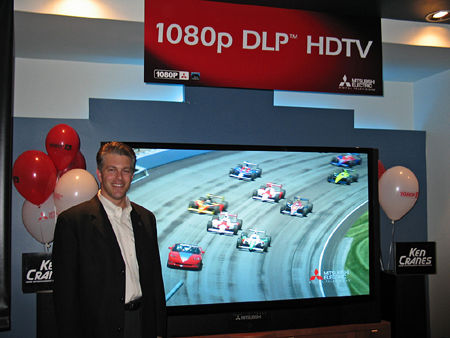Mitsubishi Wins the Race

Doug Darrow, Texas Instruments business manager for DLP brand and marketing and DLP products, next to the Mitsubishi WD-73927 73-inch 1080p DLP RPTV.
During the event, a number of demo clips were played on both sets (as well as two 720p sets flanking them) from D5 digital videotape, including trailers for Madagascar and Star Wars III as well as some custom footage from Butchart Gardens in Victoria, British Columbia, and the Indianapolis Speedway. This footage was shot on Sony F900 high-def video cameras at 1080p/30 and recorded on a Sony SR VTR with 4:2:2 bandwidth. The D5 VTR played the material at 1080i/60, which the sets deinterlaced using their proprietary internal video processing that Mitsubishi calls Plush 1080p; this processor also performs scaling and noise reduction as required.
TI makes the DMD chips and support circuitry, but they leave the actual implementation to each manufacturer in order to differentiate their products from other brands. In the case of Mitsubishi, they designed the light engine, lamp, lens, and mirrors as well as the video processor. Among the most interesting features is called DarkDetailer, which includes a dynamic aperture (iris), one of the first to appear in a DLP display. According to Mitsubishi, it increases the contrast ratio by a factor of four. Also part of DarkDetailer is a 6-segment color wheel instead of the previous 7-segment design; they dropped the neutral-gray segment in favor of the dynamic aperture to improve the contrast ratio.
Other differentiating features include DeepField Imaging, which is said to dynamically optimize contrast, brightness, and gamma in real time from one frame to the next and within each individual frame. Also, the two fixed mirrors in the light path are attached to the same engine housing instead of separate mountings, which is said to reduce light leakage and improve alignment.
The sets looked great, even in the glare of the TV news-camera lights. The shadow detail in the Star Wars trailer was surprisingly good, especially under those circumstances. Now the only question is whether or not you need 1080p resolution; depending on the screen size and seating distance, it might be physiologically impossible to tell the difference between 1080p and 720p. But under the right conditions, you will see a difference, and, like the audience at the Ken Cranes event, all you'll be able to say is, "Wow!"
- Log in or register to post comments





























































